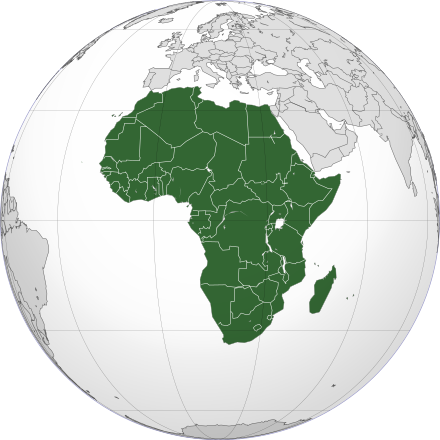Africa_(orthographic_projection).svg_.png

I have briefly mentioned Africa on this blog in the past. There are fifty-two countries in Africa but only one of them, South Africa, has a nuclear reactor. Countries that manufacture nuclear reactors and produce nuclear fuel, especially Russia and China, see Africa as a great future market for nuclear power to provide desperately needed electrification to the developing countries there. Seven sub-Saharan African nations have signed memoranda of understanding (MoU) to develop their own nuclear power plants with help from Russia.
Two years ago, Ethiopia signed a MoU with Russia for the construction of a nuclear power plant and a nuclear research reactor. Ethiopia has been aggressively working on bringing electricity to its citizens to meet the rising demand. It also hopes to become one of the biggest exporters of power on the whole continent.
Under a five-year development plan that started in 2015, Ethiopia is working to add seventeen thousand megawatts to the current national capacity of four thousand megawatts from hydro, wind and geothermal sources. The most ambitious part of the plan is a project to build the Grand Renaissance Dam (GRD) on the Nile River. This dam will provide six thousand megawatts at full capacity when it is completed by 2023. However, there are concerns that as droughts become more common, the GRD will not always have sufficient water to operate at full capacity. Plans for an Ethiopian nuclear power plant are in the “pre-feasibility stage” but government officials say that they are serious about move forward with nuclear projects.
There are forty-eight countries in Africa that are considered “sub-Saharan.” Collectively they have eighteen times the population of Spain while generating the same amount of electricity as Spain. Nearly six in ten of the Africans in sub-Saharan nations do not have access to electricity. There is a strong push across Africa to solve the power problem with massive investment in nuclear power.
The other African countries that signed MoUs with Russia’s ROSATOM include Sudan, Kenya, Uganda, Nigeria, Rwanda, Zambia and Ghana. The content of the MoUs varies from talk of reactor construction to helping with nuclear feasibility studies and training of nuclear plant staff.
ROSATOM says that its plans for managing spent nuclear fuel and other radioactive waste vary from country to country with details to be worked out on a country by country basis further along in later stages of nuclear construction projects. They claim that such waste handling procedures will be “in strict compliance with international law.”
China has also been active in peddling nuclear power solutions to African nations. They have deals under development with Kenya, Sudan and Uganda.
The strong interest in nuclear power in sub-Saharan Africa stems from the lack of fossil fuels for internal use. There is not much coal in Africa and the natural gas from the fields in Nigeria and Tanzania is exported for profit. Population increase and pressure to reduce greenhouse emissions also play a part in encouraging the development of nuclear power.
One big concern that some critics have with major nuclear power projects in some African nations has to do with the presence of weak governments and rebel groups. Spent nuclear fuel could be used to build dirty bombs or reprocessed into plutonium to build nuclear weapons. Forty African nations have joined the Treaty of Pelindaba to create a nuclear-weapon-free zone in Africa. Another concern is whether or not Russia will really meet its commitment to remove spent nuclear fuel from its African clients.
Even the proponents of African nuclear power admit that it will not be easy to quickly build the infrastructure necessary to generate and distribute significant nuclear power in Africa given the resources available for such projects.